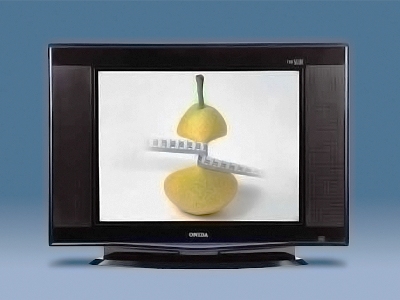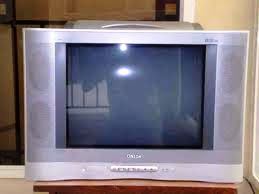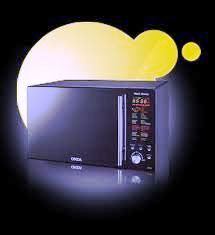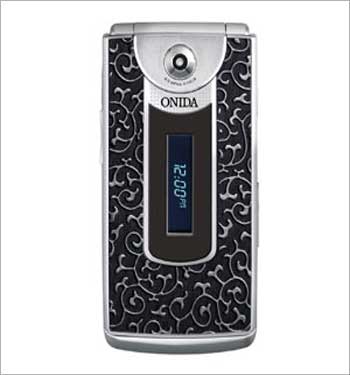Shyamal Majumdar in Mumbai
In 1976, Gullu Mirchandani was looking for a brand name for the consumer electronics products he was planning to manufacture.
He was clear about two things: the brand would have nothing to do with his surname and the name should sound Japanese.
One of the names he and his wife saw in a magazine was Oneida, which was a cutlery brand in Europe.
The husband and wife team chose that with just one modification: the 'e' was dropped.
Onida also means 'devil' in Japanese -- the source of inspiration for the devil imagery in the brand's earlier avatar.
The process to arrive at a brand name wasn't too original for a man who says he now eats, breathes and sleeps innovation.
. . .
Onida's desi innovations
But there is no denying that Onida is now innovating with a vengeance.
Mirchandani admits that was the only way his company, MIRC Electronics, could survive the onslaught of the Koreans (LG and Samsung) in the Indian marketplace.
Though MIRC has always been profitable, it came at the cost of growth and market share -- a reason why even after 30 years, the company is struggling to have a top line of Rs 2,000 crore (Rs 20 billion).
The MIRC chairman agrees with that view.
"The company suffered due to several factors including ownership issues and we realised that we either innovate, or perish," he says.
The ownership issue in the Mirchandani family has since been settled with Gullu now holding 40 per cent stake in MIRC.
. . .Onida's desi innovations
The first action of course was to graduate from just a 'TV company' as Onida came to be known as, and graduate to seven product categories, including air conditioners, washing machines, microwave ovens and now even mobile phones.
That happened over the last one and a half years.
Once the products were developed, the 'devil' and the famous tagline 'neighbour's envy, owner's pride" exited from the scene and was replaced by a new campaign -- 'tumko dekha toh design aya'.
With an ad campaign that stressed on design, Onida had to innovate.
"My brief to my team leaders was simple: every product that we launch must have an USP -- something new -- and the design has to be functional", says Mirchandani.
The chairman, who has put together a 150-strong R&D team, says the only way Onida can rise above the clutter in the marketplace and achieve a 20-25 per cent growth (from around 5 per cent now) is going in for a desi (local) touch in its innovations.
. . .
Onida's desi innovations
So this Diwali, the company is coming out with a washing machine with a built-in brush with bristles to scrub collars or spots.
One of the consumer connect programmes, which Mirchandani himself attended, threw up this interesting suggestion from local dhobis.
Over 90 per cent of Indian customers use a hand-brush because even fully automatic machines do not have the facility.
The new washing machines would sell in the Rs 10,000-17,000 range.
The same desi innovation was the reason for the launch of its "movie TVs" that play movies through a USB drive.
"It involved a little bit of re-engineering but we realized that it can be a pull in a Bollywood-crazy nation like ours," the chairman says.
. . .
Onida's desi innovations
The TVs with a price tag of Rs 6,000-7,000 is a "sell-out" in the rural areas and mostly sell under the brand name Ego. The company has a 12 per cent market share in TVs.
There is more.
Onida is the only brand which offers a micro-oven range with an auto-cooked menu of 120 Indian dishes.
"It took us more than a year of R&D to do it, but it was a clear differentiator from other such products that offer tips on how to make pizzas," Mirchandani says with a chuckle.
Onida is also the only company that sells ACs (10 per cent market share) that tell you how much electricity you saved, or a mobile phone that have a component to repel mosquitoes.
"Indian consumers like to trade and want a demonstration effect in the products on how he will gain. We must have a compelling story to tell", Mirchandani says.
The same innovation drive went in for India's first anti-glare LED televisions which the company has just launched.
. . .
Onida's desi innovations
No wonder, Mirchandani has moved away from day-to-day operations, but continues to head the R&D wing of the company.
Onida has also gone in for region-specific innovations. Example: in North India which prefers loud music, the speakers of its TVs have more bass effect, while in South India, the accent is more on treble.
This, Mirchandani says, can't be replicated by MNCs who bring only standardized global products into India.
But Onida has still not ventured into 3D TV sets, already launched by its MNC competitors.
Mirchandani doesn't sound too convincing when he says that he has read reports that 3D sets are harmful to the eyes and he isn't quite sure whether India is a big enough market for such expensive stuff. But probe a little deeper and he is forthcoming with the real reason: "It's a hugely capital-intensive exercise and we aren't quite sure about the payoffs".
So the company is treading the path of low-cost innovations that can reduce the price of the products.
"India's consumer story is of declining prices. So you have to get to the next level of products to protect your margins before the existing ones outlive their utility," Mirchandani says.
. . .
Onida's desi innovations
That explains the company's efforts to come up to speed as far as new launches are concerned.
Onida was earlier launching just one or two models in three-four years.
That was almost suicidal as Indian households have started replacing their TVs every six to seven years compared to the earlier trend of 12-13 years.
Onida is now annually launching 15-20 LCD television models, 12-13 otherTVs, six to seven washing machines and eight microwave ovens.
Even in DVDs, which Mirchandani says, is a dying product, the company is going in for two to three new models every year.
MIRC has also gone in for very aggressive advertising and upped its budget to Rs 150 crore (Rs 1.5 billion) this year from Rs 100 crore (Rs 1 billion) last year and is planning to increase its reach by setting up 200 showrooms by the end of next year.
"I would rather sacrifice my margins and spend more on advertising and distribution as the products have to be seen and easily accessed," Mirchandani says.









article